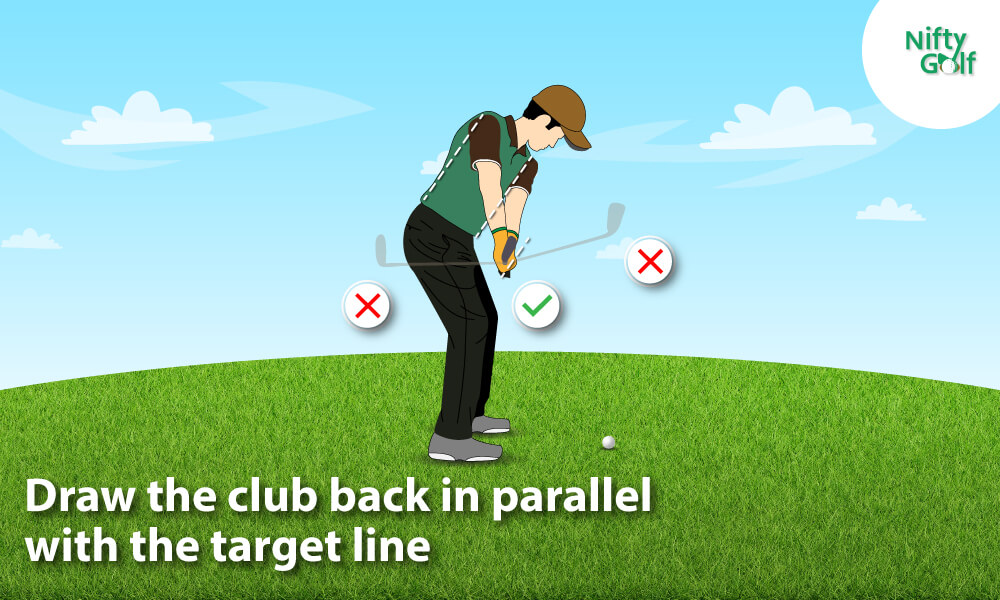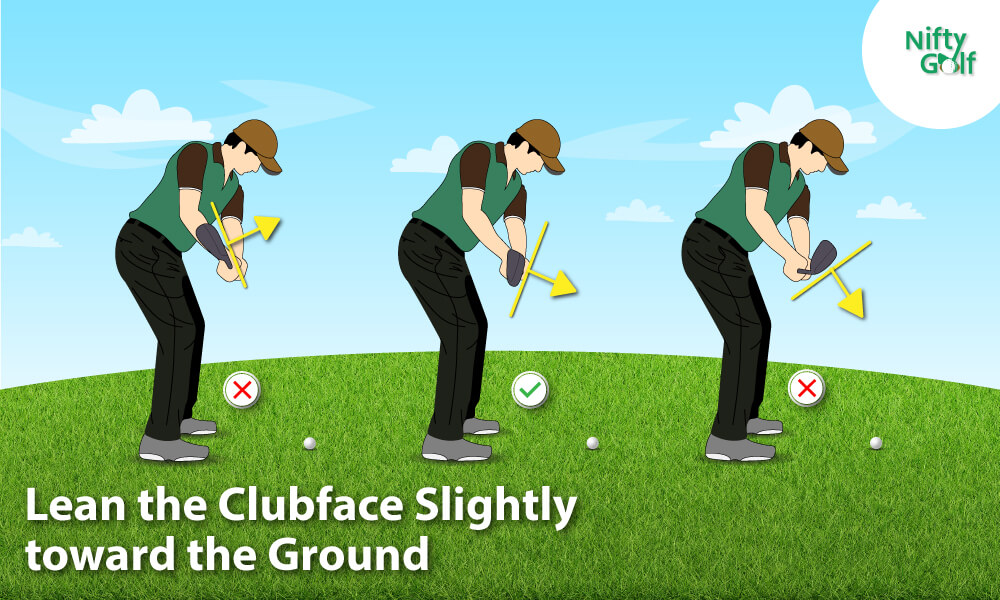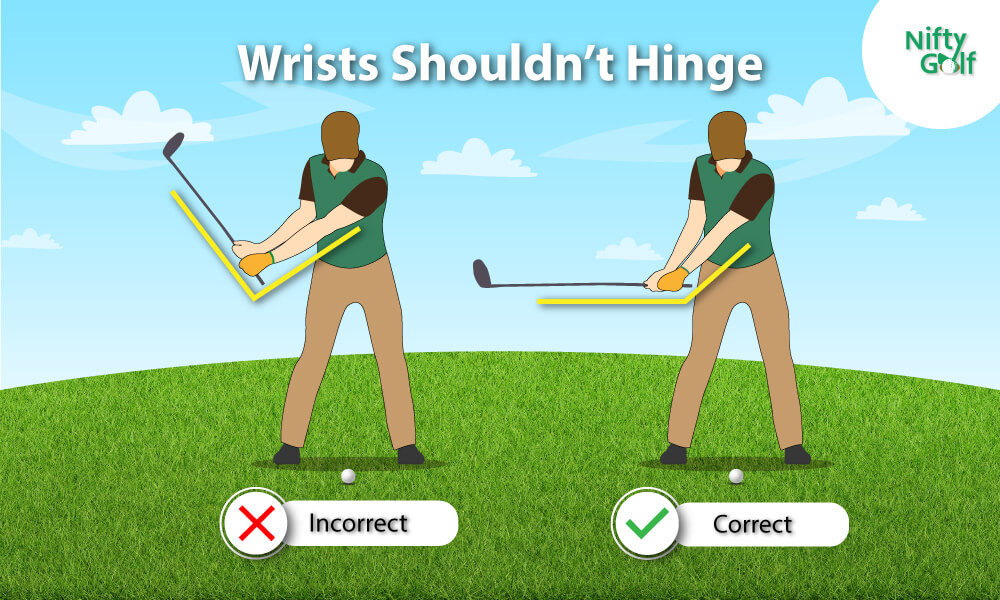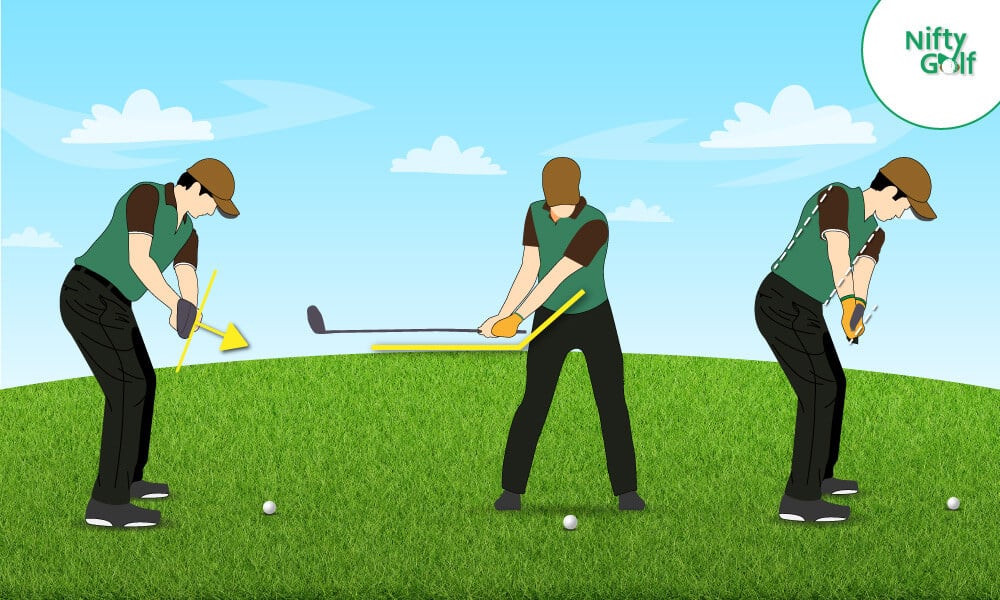The takeaway is often an overlooked term for most golfers. A general reason is “a takeaway” is only a tiny part of a full swing. Beginners tend to focus on advanced concepts and drills to be game ready. What they don’t know is none can walk before learning to crawl. Likewise, none can learn proper stroke without learning about a takeaway. This article will go all the way into the golf takeaway concept and give different strategies to make them the most effective.
Table of Content
- What is a Golf Takeaway?
- Why Is the Takeaway Important?
- Common Takeaway Methods
- Hands & Arms Position During The Takeaway
- Head Position During Takeaway
- Common Mistakes During Takeaway
- Drills for Better Takeaway
- Characteristics of a Perfect Takeaway
- How to Initiate an Effective Takeaway
- Frequently Asked Question
- Conclusion
What is a Golf Takeaway?
A golf swing takeaway is the first movement of the golf club. It is the very beginning of your backswing. It is the first 12 inches in the club moving away from the ball.
This may seem like a small distance, but the destiny of your shot can be decided during the phase of your swing. Golfers that struggle to break 100 often have a critical breakdown in their golf swing takeaway. Once you make a mistake here, it’s hard to come back from it.
Even worse, it can create bad habits in other golf swing parts. For example, if you jerk the clubface to the inside during your golf swing takeaway, you will feel “stuck” and have to flip the clubface at impact to get it square to your target. Unless your timing is perfect, this will cause you to duck-hook the ball to the left or block it to the right.
Why Is the Takeaway Important?
An appropriate takeaway aligns the torso, hands, arms, and club on the ideal swing plane. It is part of a backswing between the initiation and when the club gets parallel to the ground.
A misaligned clubhead during a takeaway can never make a shot to hit a ball in the correct direction, regardless of how effectively the remainder of that swing is done. The takeout drives your swing through the proper path from the very start, increasing the likelihood that the remainder swing will take the right plane.
Nervousness is the most common cause of starting with a bad takeaway. A tense man can’t harmonize between his hands and arms. He tends to dominate the takeaway with the arms first and tug their clubhead off the swing.
A takeaway done properly will sync the arms, hands, and body. It will resolve most issues that are usually liable for a failed swing.
Common Takeaway Methods
You can perform a takeaway via several methods. Here are the most practiced two:
1. One-Piece Takeaway
The one piece takeaway is defined by the triangle formed by the shoulders and arms at the address. Maintaining this triangle as you start your swing is vital to a successful one piece takeaway. This triangle established during your set-up should move as a single unit. When wearing a Swing Align device, it is very easy to look down and see this triangle formed by the alignment rod across your chest and your arms hanging down to grip the club. The point of the triangle is where your hands hold the club.
2. Right Arm Takeaway
A much preferable way to take the club back is by using the right arm to ” lift” the club via the right arm and letting the left arm come for the ride. As explained above, this incorporates more of a “pulling” force on the club, which allows it to remain in line with the path of motion that the hands take.
The right arm takeaway is largely controlled by contracting the right arm bicep. Like any proper takeaway, the club traces the “optimal plane” and preferably ends in the position shown in the picture above. The defining characteristic of this takeaway is the fact that the right arm is doing most of the work, and most will feel as if they are swinging the club with only the right arm. Of course, this isn’t the case, but is the intended “feel.”
Hands & Arms Position During The Takeaway
It is critical to think about hand and arm positions during the golf takeaway. During this period, many golfers made the mistake of raising the golf club. Since raising the club above natural elevation at the top of the swing is complicated, this may cause issues.
You will have difficulty correcting your swing if your arms and hands lift too quickly. In takeout and impact postures, it is vital to maintain the connection between your hands, arms, and elbows. A golf tip that emphasizes how the hands should not move independently from the body during such moves, on the other hand, is helpful advice because these talents require remarkable athleticism to be consistently successful.
Keeping your hands and arms close to your body can help you maintain balance and consistency in your golf game, regardless of your takeaway technique. It is critical because it produces a repeatably stable swing, contributing to good performance.
Head Position During Takeaway
Golfers argue about where to put their heads during swings. Some say to keep it straight with the ball, while others suggest moving it behind for power.
Whatever your position is on this, one thing is certain: don’t move your head. The club’s position, shoulder turn, and other issues can all be ruined if you move your head; therefore, this is important.
Avoid swaying side to side or moving your head up and down when you take the takeaway. To get into the wrist hinge portion of your swing, conserve some lateral head movement, even if you enjoy it.
Common Mistakes During Takeaway
During the initial phase of the golf swing, most players commit some common mistakes.Such as:
Wrist involvement
While necessary for power and angle creation, excessive wrist involvement in the golf swing might result in poor performance if the wrist hinge happens too early.
It is difficult for golfers, especially those unfamiliar with proper swing takeaway, to start the swing with their wrists. The problem is that wrists have smaller muscles. Major muscles, like the shoulders, must be engaged to maintain consistency in golf.
Smaller muscles are more likely to wander from the planned route, but larger muscles help guide the swing, ensuring the club stays on track and the body turns properly. Starting the golf swing with the wrists rather than the shoulders, arms, or spine rotation is a bad strategy that frequently leads to inconsistency.
Takes the club too far
Maintaining a straight path is critical during the initial phase of your golf swing takeout. This guarantees that the club returns to its original position as the golf swing progresses.
A common mistake in the takeaway is when players take the club too far outside the desired route. This frequently occurs when the concept of keeping the club straight back is overemphasized, prompting golfers to push the club too far along the line.
Your golf swing takeaway eventually ends, and the club must gently hinge and revolve around you.
Avoiding Raised Club Position in the Takeaway
Recovery becomes difficult when the golf club rises too high off the ground during the takeaway. A few inches of elevation often indicates hand and wrist involvement, making the club off the intended plane.
A good takeout strategy is to direct the club back with a low and slow action. This activates greater muscles and keeps the club on a shallower plane.
If you notice your club rising significantly during the takeaway, this could signify bigger problems in your swing. Many people have a slice and make uneven contact with the clubface.
Drills for Better Takeaway
Golf takeaway drills are an excellent approach to enhance your takeaway. You can discover drills that improve nearly every aspect of your golf swing. Here are some of the drills for better takeaway.
Leaf Drill
This exercise will help you practice a low, leisurely takeout using a ground tee or a leaf. If you get a little carried away during takeaway and want to raise the club straight up instead of gliding it along the ground carefully, this drill is for you.
Get a broken tee or a leaf that can be placed six to eight inches behind your golf ball. Focus on crossing over the leaf or tee you placed behind the ball as you swing the club back. The club aims to make contact with this leaf or tee. If the club goes over the ball without making contact, it could be because you’re not using the proper low and slow method to takeout, lifting the club too quickly.
Stop & Check Drill
Golfers can perform a partial backswing and then pause to evaluate their club’s position. Regularly checking your swing is useful for ensuring the club travels in the correct direction. This stop-and-check drill is popular among golfers for fine-tuning their swing.
Establish certain checkpoints in your swing, such as when the club shaft is parallel to the ground. In doing so, you will begin feeling rotation in your hips and shoulders, providing a solid golf swing rotation.
Check the club face to ensure it hasn’t opened or closed unusually. It’s not required to manipulate the club face during the takeout; it often adjusts automatically as you turn behind the golf ball. Stop following your golf swing, move into the address position and finish with a complete swing.
Keep this routine, and try different golf clubs at it. Takeaway is essential for both drivers and irons.
Basketball Drill
A basketball or even a bucket of empty-range balls will work for this exercise. You will address the golf ball and use your club to replace it.
Keep the ball at your sides as you swing the club. Before beginning your takeaway, check if the ball has moved from its original spot.
Ensure you don’t spin the golf club while doing your takeaway. If you do so, the club’s face will either open or close depending on your rotation, forcing you to recover before impact.
Chest Arm Drill
The arms on the chest drill are similar to the basketball drill in that you will not need to use your club to finish it.
You should cross your arms and place them on your chest for this drill. Each hand should be in contact with a shoulder. Start your golf swing from this stance.
Without focusing on the golf club, you will feel what it takes to initiate the body turn. This is an excellent practice for individuals who habitually involve the club too much in the takeaway. This is a wonderful golf drill if you’re having trouble incorporating larger muscles into your golf swing.
Characteristics of a Perfect Takeaway
A perfectly crafted takeaway will offer a few distinct edges to you. Knowing about these edges or features will help you further attempt to create ideal swings. Here are a few notable ones:
- It sets your body and club in the proper position from the very start. You get the optimal condition for an effective golf swing.
- It harmonizes the movement of your shoulders and arms while
How to Initiate an Effective Takeaway
You must have already realized that the magnificence of golf is unfathomable. The game consists of many distinct components, each of which plays a function. Your legs represent the longest muscles in the body and contribute to power production. Your waist and hips generate speed, while the forearms contact your wrist hinge, resulting in a massive energy transfer.
All these functions of different muscles have unique roles to play during a takeaway. It’s crucial to place and twist them as necessary. Here is a guideline for using different components to create the perfect takeaway:
1. Point the Shaft at the Target
The club must be aligned with the target during a takeaway. You should ensure that the club’s shaft and the ground are parallel. You should also point the club straight forward along a line parallel to the target line.

2. Lean the Clubface Slightly toward the Ground

When a takeout ends, when the shaft of the club gets parallel to the ground, the clubface position and direction it faces are both important.
In point of fact, for shots that are airborne with extreme force and follow a straight path, the dominant edge of clubs should lean slightly towards the ground and the ball. This will allow these shots to pierce the air with the possible vigor.
3. Wrists Shouldn’t Hinge

Ideally, the club shaft should be parallel to the ground because the shoulders rotate away from your body. This contrasts with the clubhead coming higher rapidly via a wrist bend, which is undesirable for most regular strokes.
Frequently Asked Question
What Happens After The Takeaway?
After the takeaway, golfers easily transition into commencing a wrist hinge, signaling the start of the backswing. The club ascends as the takeaway ends, reaching the top of the golf swing. Although the hands and wrists are responsible for making manual adjustments, the positional movement of the club shaft is the consequence of the coordinated turn and rotation of the body.
Is the takeaway different at different clubs?
Yes, the takeaway differs for every club, but the essential idea remains the same. When making a throwing wedge, keep it short and aim for accuracy. Try a longer backswing with more extension to obtain extra distance when utilizing a driver. The length of the clubs also matters—woods are longer than irons, which affects how the takeaway looks. Adjusting your takeaway for each club allows you to maximize performance throughout your set.
Conclusion
Like every other game, golf has small components. For golf, these small components will be golf swing, alignment, position, set-up, takeaway, and so forth. Often underestimated individually, these components are the prime factors for a dead straight stroke and better performance.
As of now, put some time and effort into replenishing your takeaways. You will be amazed by the improvement a perfect takeaway brings to your swing.

